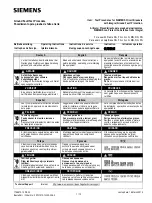
Installation Checks and Initial Functional Tests
Introduction
This section provides a description of the inspections,
checks and tests to perform on the circuit breaker prior to
operation.
Inspections, Checks, And Tests Without Control Power
Vacuum breakers are normally shipped with the primary
contacts open and the springs discharged. However, prior
to starting the inspection process, it is critical to
first verify
that the control power is de-energized and the spring-
loaded mechanisms are in the discharged condition.
De-energizing Control Power in a Power Circuit Breaker -
To de-energize the control power, open the disconnect de-
vice in the secondary control compartment. Figure 6 shows
the location of this disconnect in a standard breaker.
The control power disconnect device is located on the con-
trol panel in the secondary control compartment. Figure 6
shows a knife switch with fuses. Opening the knife switch
de-energizes control power to the circuit breaker. In some
breakers pullout type fuse holders or molded case break-
ers are used in lieu of knife switches. Removal of the fuse
holder or opening the molded case breaker accomplishes
the same result: control power is disconnected.
Figure 6.
Control Power Disconnects in Power Circuit Breaker.
Figure 7. Operator Control Panel of Power Circuit Breaker.
Spring Discharge Check (Figure 7)
The spring discharge check consists of simply performing
the following tasks in the order given. This check assures
that both the tripping and closing springs are fully dis-
charged.
1. De-energize control power.
2. Press Trip pushbutton.
3. Press Close pushbutton.
4. Again press Trip pushbutton.
5. Verify Spring Condition Indicator shows DISCHARGED.
6. Verify Main Contact Status Indicator shows OPEN.
2078-98
2082-98
Manual
Trip
Manual
Close
Hazardous voltages and high-speed
mechanical parts.
Will cause death, serious injury or property
damage.
Read instruction manuals, observe safety
instructions and use qualified personnel.
2089-98
10










































